The Record Store Years (Side Trip): Raffaelli: Recollections of a Photographer
A memoir of 25 years (1975-2000) spent working in the world of records & music in Seattle, with occasional side trips into writings on Led Zeppelin and other adventures from my musical life.
This piece is from my Led Zeppelin fanzine Proximity #33, published in April 1999. I had known Raffaelli’s work from my very early days as a Zep collector in 1970 – his ‘heavy metal’ poster was a fixture on the wall of my bedroom as a teenager – and with the launch of his web presence in 1999 I took the opportunity to track him down for a phone interview.
He was an engaging character, generous with his stories and recollections and eager to promote his new online endeavor despite seeming a little surprised at the enduring interest in his rock photos.
Ron Raffaelli passed away in 2016. His Wikipedia page is fairly comprehensive however his general web presence is minimal and I don’t believe his work is currently available, at least from an authorized source. I have included some of his images here based on the permission he gave me back in 1999.
Raffaelli: Recollections of a Photographer
[Content Note: Some of the attitudes described in this piece regarding women could cause offense. As Marc Maron would say, “. . . it was a different time.”]
Ron Raffaelli has been a professional photographer since he graduated from the Art Center College of Design in Los Angeles in 1969. He is probably best known for his erotic work, published widely in adult magazines and in four books including the successful Rapture, published by Grove Press in 1975.
However early in his career he worked extensively in the world of rock ‘n’ roll, capturing legends such as Hendrix, Zeppelin and The Rolling Stones in that golden era for rock as the ‘60s turned into the ‘70s.
An American of Italian descent, Raffaelli (as he is usually billed) was born in Hollywood in 1943. His father worked in the film industry and Ron grew up close to the Hollywood entertainment world, which helped him get his start after setting up his first Los Angeles studio on Melrose Avenue in 1969.
Initially he did a lot of freelance work shooting still photographs on movie sets for publicity and use as lobby cards at the theatres, and this led to other commercial work for ad agencies and ultimately record companies, which is how he got into photographing rock groups.
His best-known image in the rock world is undoubtedly the striking superimposed-heads shot of the Rolling Stones used on the cover of their double-album hits collection Hot Rocks (London Records 1971, pictured below left). However Zeppelin fans will be most familiar with Raffaelli from two posed group shots of the band that have become timeless images – the “heavy metal” portrait used for a famous commercially released poster in 1970 (pictured above), and the front cover of the 1969 Visual Thing hardcover ‘tour book’ (below right) depicting an enigmatic-looking Jimmy Page with his hand extended towards the camera while Bonham, Jones and Plant pose soberly behind him.
“I love darkroom magic and doing experimental things in the lab,” says Raffaelli, talking about his evolution towards shooting rock in the late ‘60s. “The advertising agencies wanted a straight shot of the soup can, they didn’t want sparks coming out of it. There wasn’t a lot of creativity in that end of it, so I really gravitated towards doing record covers and posters, because it was a psychedelic time.”
“I created the Zeppelin poster by having a metal engraving made from a black and white photo. I then photographed the engraving using colored side lighting. I was pleased with the final result because this was the first ‘Heavy Metal’ poster.”
Raffaelli’s move to prominence during that time came with a company he was partner in called The Visual Thing. “We made contracts with some of the top groups at the time to do tour books that were mainly sold at concerts, and later we had posters too. A company in Pennsylvania printed the posters, and in the end whatever tour books were not sold at shows were than packaged and sold along with the posters.”
A handful of Visual Thing books ended up being published. In addition to the superb Zeppelin one, books were created in similar twelve by twelve inch, 20-page formats for Jimi Hendrix, Iron Butterfly, Blind Faith and at least five other bands (see comments at the end of this piece for details). They contained a combination of black and white and color photographs artfully laid out with little or no text, and most of them were hardcover publications.
The Hendrix book, called Electric Church/A Visual Experience, is particularly elaborate, with a three-panel foldout cover and a heavily effected psychedelic image of Jimi later used for a poster on the front cover. Raffaelli shot Hendrix and the Experience in Hawaii in October 1968, resulting in a series of famous photos (one of which also became a poster) showing the band posing with a pair of naked hippie girls, along with the live concert and other posed images used in the book.
The Blind Faith book features a front cover shot of Clapton, Baker, Winwood and Grech posed in front of a nude woman crucified on a cross, typical of the dramatic and occasionally controversial images that sprang from the creative collaborations between Raffaelli and the bands he worked with.
Above: The front and back covers of the Visual Thing books, left to right: Hendrix, Blind Faith and Iron Butterfly. These 12” by 12” books are often referred to as ‘tour programs,’ which is not strictly correct – while their production was authorized by the artists and they were sold at some concerts, they were not ‘official’ programs affiliated with any particular tour as is usually the case.
“I was the director of photography (for The Visual Thing) and a lot of times the groups we worked with were not big yet – I shot Three Dog Night when they were still playing in high school auditoriums. The people in the music industry we worked closely with would say, ‘this is going to be a big group, this group’s gonna do it’, and nine times out of ten they would. So you would want to get a poster deal with a group early.”
Raffaelli’s work with Led Zeppelin occurred mostly in 1969 and included accompanying them on several tours throughout Europe, England and a little bit in the United States. He also shot them at several sessions in his own studio in Hollywood and on at least one occasion at Quantum Recording Studios in Los Angeles during a session for Led Zeppelin II.
His affiliation with the band began in June 1969 when he photographed them at a show at the Town Hall in Birmingham, England. It is these photos that comprise all of the live concert images used in the Visual Thing Zeppelin book, and also mark the occasion of one of the strangest experiences of Raffaelli’s entire career as a photographer.
“I had another commitment and had to get back to the United States right after that concert, so I packed up all my equipment and flew back the next morning,” he recalls. “The first thing I did when I got back was develop the film, and I was shooting with a Nikon ‘F’, which is a 35mm single lens reflex camera that you can’t use to shoot a double exposure. Some of my studio cameras you can double expose with because the advancing of the film and the cocking of the lens are two separate things, but with the Nikon it’s all one thing and you can’t disengage it.
“As I developed the film I found pictures on that roll with ‘ghost’ images on stage with Led Zeppelin. And I remember being backstage with the group before the concert and they were talking about how this concert hall had been built on top of the ruins, or foundation, of what was once a medieval prison where there was a lot of torture and things like executions going on.
“I hadn’t thought of this until I saw what looked to me like double exposures - there was one with a large face and you can tell that it’s been mangled – it’s a deformed human face - and it looks like it’s in pain or something. It was very interesting.”
Less mysterious but perhaps equally bizarre is a long-hidden image Raffaelli photographed at the specific request of Jimmy Page.
“After touring with the band I became very close to them, and on a long flight from London to New York, Jimmy Page told me about a recurring dream he had. In this dream Jimmy falls from the concert stage into the flailing arms of a sea of screaming fans. He is stripped of his clothes and forced to have sex with many beautiful groupies. After satisfying the last beauty, he falls on his back too exhausted to move. She kneels between his legs and tries to arouse his spent manhood. Failing to bring his penis to life she opens his stomach and eats his intestines.
“I said, ‘that’s a pretty weird dream,’ and Jimmy replied, ‘I enjoy this dream and would love for you to take a picture of me having my insides being eaten by a naked girl.’”
Thus it came to be that in December of 1969, Raffaelli set up a photo shoot at his studio for Jimmy to turn his dream fantasy into a fully realized photographic image.
“I had an assistant go down to the butcher and get these entrails,” recalls the photographer, “and they smelled like crazy! So I insisted that they be kept in a can out on the back porch of my studio for this is early morning shooting, and we weren’t going to bring them in until we had to because of the smell.
“Page came in with this model, some groupie that was hanging on to him at the moment. I don’t remember her name, it was ‘Moonbeam’ or something. . . and I had the private set ready so there was no one there but him and me and this model. They stripped down and I got them all posed and everything and I said, ‘ok, I’m going to bring in the. . . uh. . . entrails,’ and by now the sun had come up and it was heating them up so they were warm. They smelled even worse but at least they were warm.
“I put them on him and got it all posed, but I’m looking through the camera and I’m thinking, ‘it just looks like I poured these entrails on his stomach, it doesn’t look like there’s a gash or anything.’ It just didn’t look convincing. And he’s laying there and she’s laying there and the stuff is beginning to get ripe and I’m thinking, ‘I’ve gotta think quick.’ So I run out to the kitchen and look in the refrigerator and there was my answer. I had a nice jar of strawberry preserves! I quick grabbed a long spoon and mixed ‘em up and they had the right redness and consistency, with little specks and everything. It had the right look to it like it might be the inside of a turned out open wound. So I took these cold, cold preserves - and I have to give Jimmy a lot of credit, he must have really wanted this picture - and put them all around the entrails that were on his stomach. And I know from the expression on his face and the contortions that his body was going through that this was not a comfortable situation!
“I originally shot it in black and white and gave Page a sixteen by twenty print, and I also shot color at the same time that I just developed and rolled up into a ball and stuck into a drawer and hadn’t looked at until I decided to put it up on my web site this year.
“My agent met Jimmy in New York last year and explained that we had this material and that we were intending to sell it and he didn’t have any objections to it. It’s bizarre, but I would never consider it a controversial picture by any means, it’s just bizarre and reflects a bizarre state of mind that he was in at the time. I’m sure now he looks back at it and goes, ‘Oh my God, what was I thinking?!’”
Another example of Jimmy Page’s regard for Raffaelli occurred when the photographer was having a post-concert dinner with the band at a restaurant in England.
“It was one of my first trips to England and I just wasn’t used to the English food. . . it was hard for me to drink a Coca Cola at room temperature,” says Ron.
“I asked the waiter if I could have some ice and the restaurant people were running around, running around, and finally they came back with a lot of apologies to say they just didn’t have any ice. And Jimmy Page says, ‘Wait a minute, Ron wants some ice in his drink, I’ll take care of it.’ And he had the band’s limousine driver take somebody from the kitchen someplace where they had ice and they came back with a bucketful, and I got ice in my Coca Cola!”
Back in the United States, Raffaelli had the opportunity to shoot the band on several other occasions. There is a fascinating photo in the Visual Thing book showing Page working an old-style mixing console at Quantum Studios in Los Angeles, deep in concentration, as a nameless engineer looks in with an expression on his face that could be described as awe.
“I have overall impressions rather than individual memories,” claims Raffaelli, “but I can remember hanging out with them. I used to spend a lot of time in the recording studios with these groups getting to know them, because that’s where they lived.
“They fucked their girlfriends there, they ate their dinners there, they did everything in the recording studio so if you were going to go and get to know them them, the best place was always the recording studios.
“I enjoyed that aspect of it because this was, you know, a hardhat area. This was where they were doing their work. It was pretty restricted access and that’s where the creativity was flowing.”
Environments such as the concert stage and recording studio were easily accessible to Raffaelli, but getting Led Zeppelin into his own photography studio where he could control the lighting and pose them to his liking was a different story. “For them it was like going to the dentist. They’ll do it if they have to, but it’s a chore for them to be photographed.”
On one occasion Ron lured the band into his Hollywood studio with the promise of a session they would not soon forget. “The group showed up and I immediately posed them on my set and clapped my hands for for an assistant to bring me my camera. From the back of the studio a tall, beautiful, completely nude blonde model appeared carrying my camera on a silver tray. Needless to say I had the group’s complete attention for the duration of that session!”
It was that kind of creative panache - with a touch of the outrageous - that endeared Raffaelli to even the most pampered and egotistical members of the rock elite, and made him an in-demand photographer for the duration of his career in rock.
Ironically, it was his best-known rock image - the Rolling Stones photo used on the cover of Hot Rocks - that indirectly led Raffaelli to eventually leave rock behind to find success in the world of erotic photography. Jeffrey Michelson, who was an art director at Apple Records, was introduced to Raffaelli through that particular photograph, and it was Michelson who a few years later became editor of Puritan magazine, remembered how much he liked the Stones shot, and called Ron to shoot erotic material for his publication.
Raffaelli had been shooting rock ‘n’[ roll for about four years when he began to get frustrated. “I didn’t want to just be a portrait taker,’ he recalls. “So many of these groups, even after I had shot the legends, came along and said, ‘ok, what are you going to do for our album cover?’ and I’d explain what my idea was and they would say, ‘well, where are we gonna be?’ They had all promised their mother, their girlfriend, somebody that they were going to be on an album cover someday, so they didn’t want anything except their pictures on the cover. And that’s great if you’re the Rolling Stones because people know who you are and want to see you - maybe. But if you’re the Five Man. . .uh, Unwired band. . . then nobody knows you from Adam and you’ve got the same beard and moustache and weird look as everybody else in the business. Why are they going to buy this album among the thirty or so released that month?
Above: Some of Ron’s album cover work from the early ‘70s.
“I would try and explain to them that you’ve got to have some image that’ll make that person pull the album out of the bin, turn it over and read the names of the songs and something about you, and get interested in your music. You’re not going to do it by your good looks.
“And that was a losing argument as time went on and I felt I was just a portrait-taker of scruffy guys when my real interest was in beautiful women, thank you! So I decided to get out of doing album covers because these people weren’t listening to what I was telling them and I would rather be shooting beautiful women, which was becoming more possible and practical because I was getting publishing contracts and assignments from men’s magazines.
Above: Some of Ron’s erotic work from the ‘70s and early ‘80s.
“I went into that and happily left the music industry behind, and now, nearly thirty years later this material that’s been in my archive for so long is looked for again.”
Early this year [in 1999] Raffaelli, with the urging and assistance of his nephew Anthony, exhumed some of his best images from that archive and launched a web site offering for sale high quality photographic prints of his most memorable images of Zeppelin, Hendrix, Clapton and others. The response has been impressive.
[NOTE: as of 2024 this site is no longer active]
We’ve only been online since the first of the year and already I’ve been flooded with orders and questions about my experiences during that part of my career. For over twenty five years I’ve photographed some of the most beautiful women on the planet, published five books and produced over fifty adult films. So I’m a little surprised to receive this much attention for the four years I spent photographing scruffy men!”
That attention is, of course, not so surprising to those of us in the world of Zeppelin collecting. Raffaelli’s work is of lasting quality and much of it is extremely unique. Outside of the obviously unusual images such as Jimmy’s dream sequence, his posed portraits of the band capture glimpses of Led Zeppelin at a pivotal early point in their career that are notable for vividly portraying the relaxed confidence of the band.
Many of Raffaelli’s Zep images seem to emphasize the unique mix of personalities that made up this most incredible of rock groups. Plant and Bonham, barely out of their teens, look serious and intense. John Paul Jones, the seasoned vet, affects occasional disinterest or a solemn intensity similar to Plant and Bonham. And Jimmy Page, usually posed up front or in the center of the group, just oozes relaxed confidence, staring straight into the camera’s lens with a look that seems to say, “This is it – I’ve assembled a band that’s going to rule the world and I know it.”
NEXT: Early Adventures: The First (and only) Cellophane Square Concert
Below: Some of the 24” by 36” wall posters produced by the Visual Thing in 1969 & 1970, and a two-page spread from the Led Zeppelin book.

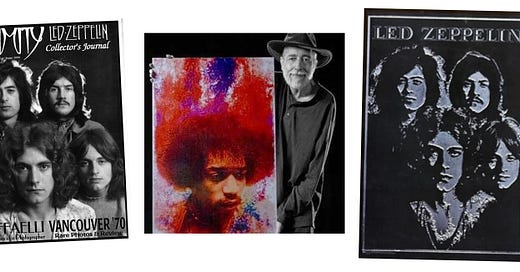




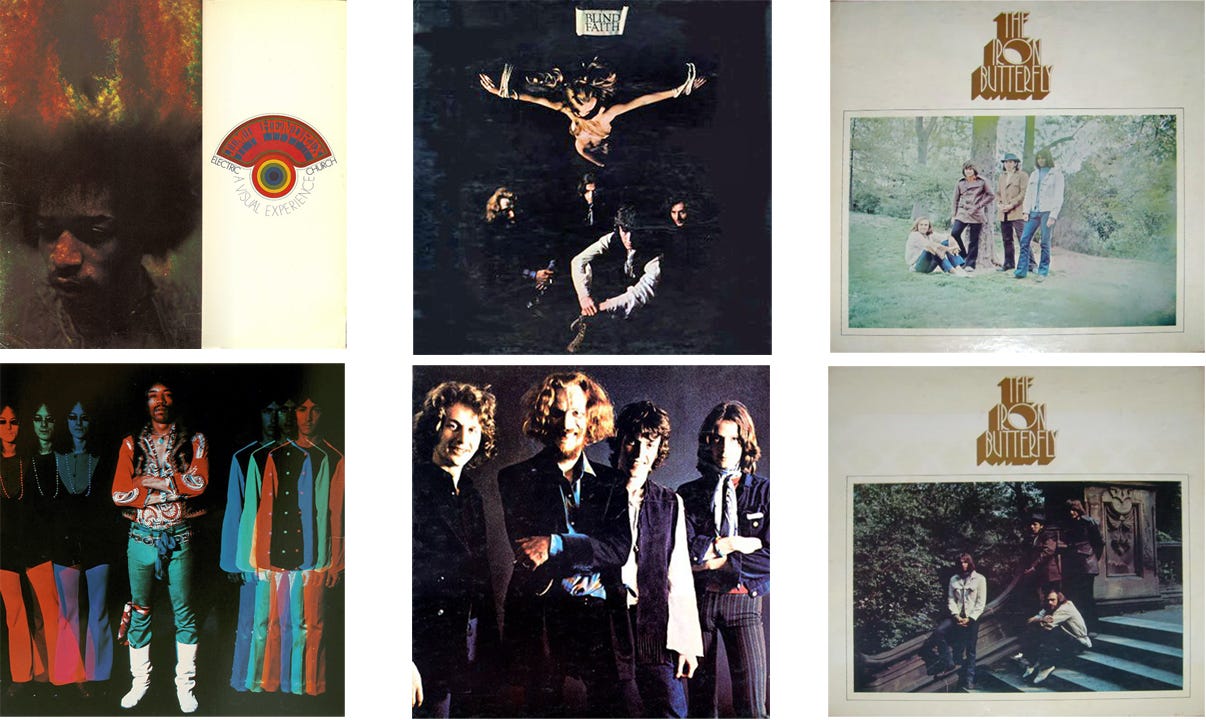
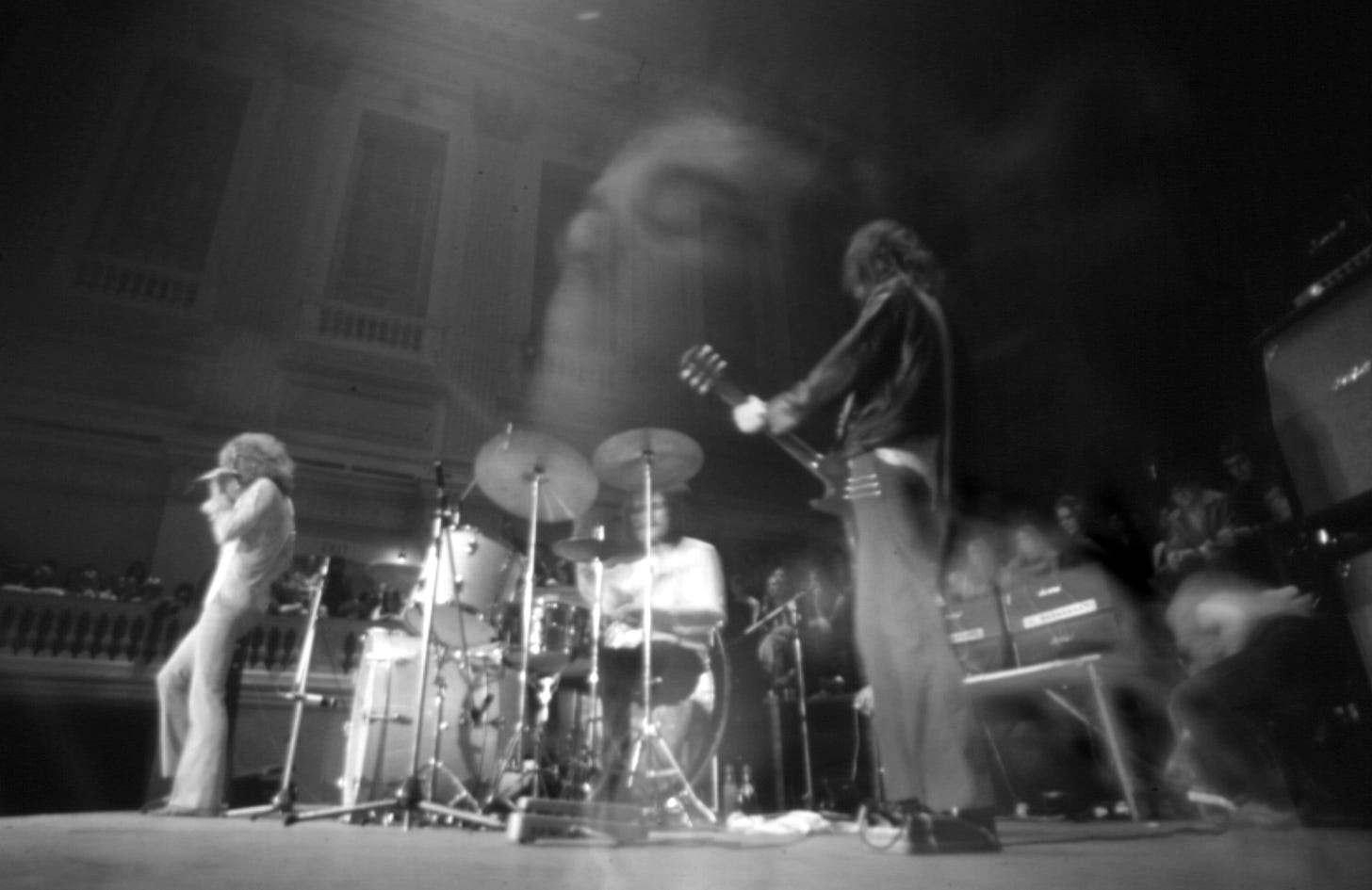
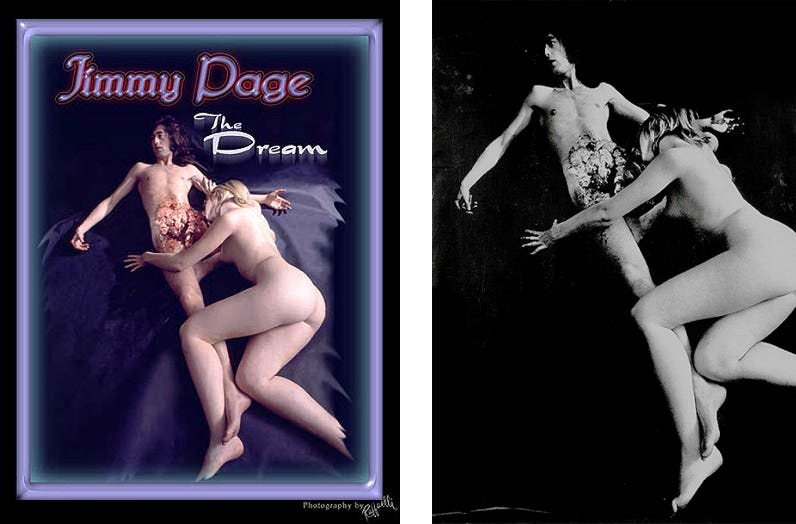



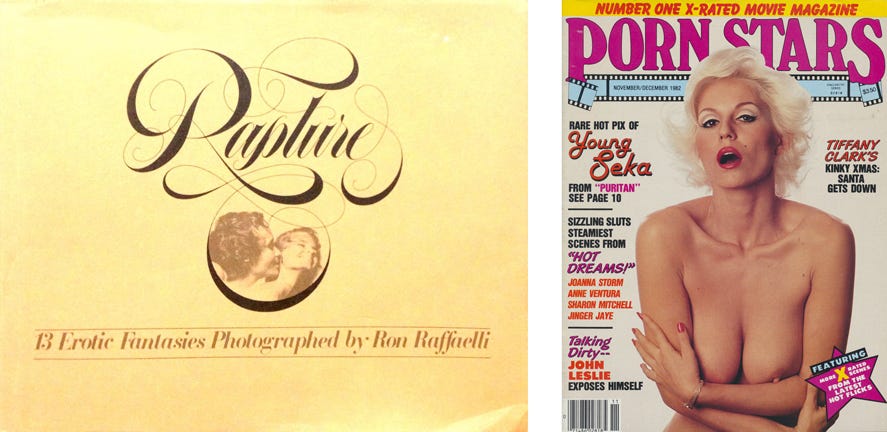

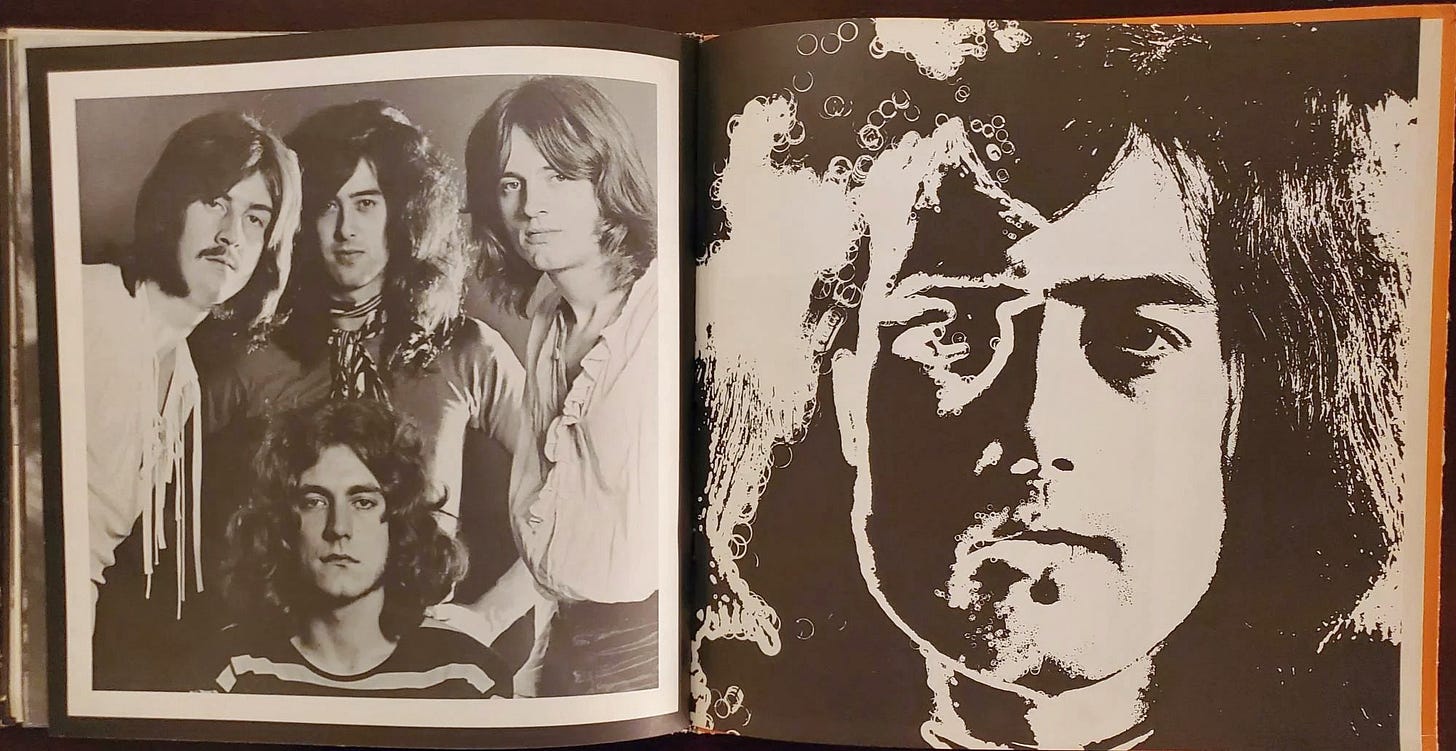
Wow - really cool piece! Thanks for this!
killer piece on a little known photographer with a keen and inventive eye. Much appreciated!!!